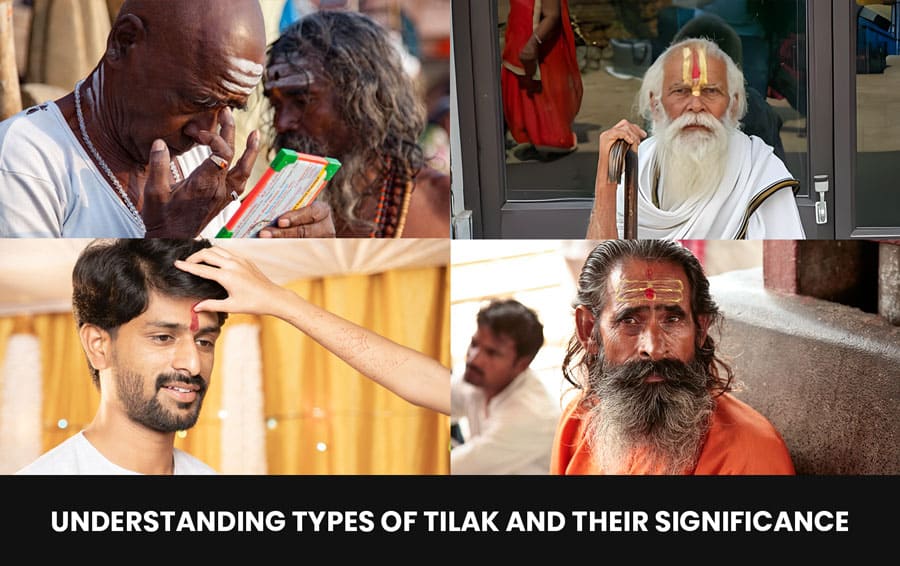
In the vibrant world of Hindu traditions, the tilak stands as a symbolic mark, adorning foreheads with a unique blend of aesthetics and spiritual significance. This sacred marking, often made with sandalwood paste, ash, or vermilion, transcends mere decoration and delves into the realms of religious affiliation, personal beliefs, and blessings. But amidst the diverse landscape of Hindu practices, various kinds of tilak emerge, each carrying its own distinct story and meaning. Let's embark on a journey to explore the different types of tilak and their unique significance.
Since india is a diverse country, In the hindu culture there is not just type of tilak. There are more than one Type of Tilak exist, breakdown all different types of tilak. Eather it is types of chandan tilak or types of tika on forehead.
Tripundra (Rudra Tilak):
Rudra Tilak, This horizontal trio of lines, often embellished with a central dot, is a signature mark of Shaivites, devotees of Lord Shiva. Made with sacred ash (Bhabhut), it symbolises Lord Shiva's three divine powers: will (iccha), knowledge (jnana), and action (kriya). The dot in the centre represents the supreme consciousness, reminding us of the infinite divine within.
Vaishnava Tilak, For Vaishnavites, followers of Lord Vishnu, the tilak takes on a distinct form. Two vertical lines, sometimes connected at the top, resemble the letter "U" and represent Vishnu's feet. This tilak is often made with sandalwood paste or clay, symbolising Vishnu's grace and protection.
Gopichand or Gopi Tilak, This circular mark, adorned with a central dot, finds its root in the legend of Radha and Krishna. Worn by women, particularly in Vrindavan, it's said to represent the love and devotion of the gopis towards Krishna.
The vibrant red dot of kumkum is a widely seen tilak, not confined to specific sects. Worn by married women and widows alike, it signifies auspiciousness, marital bliss, and prosperity.

This red sandalwood paste is types of tilak on forehead, often seen adorning the foreheads of sadhus and ascetics. It symbolises the renunciation of worldly desires and the pursuit of spiritual liberation.
From the "Triputi" of Maharashtra to the "Y-shaped" marks in South India, the diverse cultural landscape of Hinduism offers various regional tilak variations, each holding unique significance within their respective communities.
While the visual representation of tilak is captivating, its true essence lies in the deeper meaning it embodies. Here are some key significance of tilak:
Religious Affiliation: The type of tilak often serves as a visual indicator of one's religious affiliation, allowing individuals to identify with their chosen path.
Blessing and Protection: Wearing a tilak is considered auspicious, inviting divine blessings and protection upon the wearer.
Spiritual Reminder: The mark is a constant reminder of spiritual ideals and devotion, keeping one focused on their inner journey.
Concentration and Focus: Applying the tilak is often an act of mindfulness, promoting concentration and focus during prayer or meditation.
Tilak isn't just a mark on the forehead; it's a window into the diverse and vibrant world of Hindu culture. It's a language that speaks of devotion, tradition, and personal beliefs, silently communicating and connecting individuals across generations and communities. As we appreciate the various kinds of tilak, we search deeper into the rich cultural and spiritual heritage of Hinduism, recognizing the beauty and significance it holds for millions worldwide.
While some tilak variations might be specific to certain sects or practices, many forms, like the red kumkum dot, are widely worn by individuals across different backgrounds. It's always respectful to understand the significance of a particular tilak before adorning it.
Sandalwood paste, sacred ash (Bhabhut), clay, and vermilion are commonly used materials. Certain regions might have specific preferences based on tradition.
Tilak can be worn throughout the day, especially during prayer or meditation. Some individuals might choose to wear it only during religious ceremonies or auspicious occasions.
There's no need to worry if the tilak fades. Its symbolic meaning and impact remain, and you can reapply it as needed.
While tilak itself doesn't guarantee or bestow any specific spiritual benefits, it can act as a powerful tool for enhancing your spiritual practice. Applying it with mindfulness and focusing on its meaning can promote concentration during prayer, reinforce your connection to your chosen deity or path, and constantly remind you of your spiritual aspirations. Ultimately, the true benefit lies in the intention and mindful awareness you bring to the act of wearing and experiencing the tilak.
For more Interesting topics follow us on Instagram
Author :